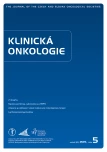Peritoneal Carcinomatosis from Ovarian Cancer – Current Clinical Impact of Cytoreductive Surgery and Intraperitoneal Hyperthermic Chemotherapy
Authors:
Dušna Klos 1; Juraj Riško 1; Jan Hanuliak 1; Čestmír Neoral 1; Radovan Pilka 2; Petr Dzvinčuk 2; Radmila Lemstrová 3; Bohuslav Melichar 3; Beatrice Duchoňová-Mohelníková 3
Authors‘ workplace:
I. chirurgická klinika LF UP a FN Olomouc 2 Porodnicko-gynekologická klinika LF UP a FN Olomouc 3 Onkologická klinika LF UP a FN Olomouc
1
Published in:
Klin Onkol 2019; 32(5): 349-352
Category:
Review
doi:
https://doi.org/10.14735/amko2019349
Overview
Epithelial ovarian cancer is one of the most common causes of cancer-related death in women. More than half of patients are diagnosed at an advanced stage, usually due to locoregional spread of peritoneal carcinomatosis. A combination of systemic chemotherapy and cytoreductive surgery has been the standard treatment since the mid-1990s. However, conventional chemotherapy is poorly delivered to the peritoneum due to the plasma-peritoneal barrier. Intraperitoneal chemotherapy can improve survival by eliminating residual microscopic disease. A combination of hyperthermic intravenous and intraperitoneal chemotherapy may reduce plasma toxicity and increase therapeutic effectiveness. Several experts are investigating the effectiveness of cytoreductive surgery and hyperthermic intraperitoneal chemotherapy for both primary and recurrent ovarian cancer worldwide. Recent randomized studies indicate that this method prolongs overall patient survival and the disease-free interval. This approach is not yet part of standard guidelines and is the subject of several other clinical trials. However, indications should be considered in women with significant residual disease after neoadjuvant chemotherapy because these patients can benefit from comprehensive surgical resection in combination with hyperthermic intraperitoneal chemotherapy to prevent locoregional relapses.
Keywords:
cytoreductive surgery – hyperthermic intraperitoneal chemotherapy – ovarian cancer
Sources
1. Sugarbaker PH, van der Speeten K, Chang D et al. Impact of surgical and clinical factors on the pharmacology of intraoeritoneal doxorubicin in 145 patients with peritoneal carcinomatosis. Eur J Surg Oncol 2011; 37 (8): 719–726. doi: 10.1016/j.ejso.2011.04.007.
2. van der Speeten K, Stuart OA, Sugarbaker PH. Using pharmacologic data to plan clinical treatments for patients with peritoneal surface malignancy. Curr Drug Discov Teachnol 2009; 6 (1): 72–81.
3. Ansaloni L, Coccoluni F, Morosi L et al. Pharmacokinetics of concomitant cisplatin and paclitaxel administered by hypertermic intraperitoneal chemotherapy to patients with peritoneal carcinomatosis from epithelial ovarian cancer. Br J Cancer 2015; 112 (2): 306–312. doi: 10.1038/bjc.2014.602.
4. Issels RD. Hyperthermia adds to chemotherapy. Eur J Cancer 2008; 44 (17): 2546–2554. doi: 10.1016/ j.ejca.2008.07.038.
5. van Driel WJ, Koole SN, Sikorska K et al. Hyperthermic intraperitoneal chemotherapy in ovarian cancer. N Eng J Med 2018; 378 (3): 230–240. doi: 10.1056/NEJMoa1708618.
6. Wang Y, Ren F, Chen P et al. Effects of cytoreductive surgery plus hyperthermic intraperitoneal chemotherapy (HIPEC) versus cytoreductive surgery for ovarian cancer patients: A systematic review and meta-analysis. Eur J Surg Oncol 2019; 45 (3): 301–309. doi: 10.1016/j.ejso.2018.10.528.
7. Hettiga JV, Lemstra W, Meijer C et al. Mechanism of hyperthermic potentiation of cisplatin action in cisplatin-sensitive and-resistant tumor cells. Br J Canc 1997; 75 (12): 1735–1743. doi: 10.1038/bjc.1997.297.
8. Ozols RF. Treatment goals in ovarian cancer. Int J Gynecol Cancer 2005; 15 (Suppl 1): 3–11. doi: 10.1111/j.1525-1438.2005.15351.x.
9. Cannistra SA. Cancer of the ovary. N Engl J Med 2004; 351 (24): 2519–2529. doi: 10.1056/NEJMra041842.
10. Bristow RE, Puri I, Chi DS. Cytoreductive surgery for recurrent ovarian cancer: a meta-analysis. Gynecol Oncol 2009; 112 (1): 265–274. doi: 10.1016/j.ygyno.2008.08.033.
11. Spiliotis J, Halkia E, Lianos E et al. Cytoreductive surgery and HIPEC in recurrent epithelial ovarian cancer: a prospective randomized phase III study. Ann Surg Oncol 2015; 22 (5): 1570–1575. doi: 10.1245/s10434-014-4157-9.
12. Bristow RE, Tomacruz RS, Armstrong DK et al. Survival effect of maximal cytoreductive surgery for advanced ovarian carcinoma during the platinum era: a meta-analysis. J Clin Oncol 2002; 20 (5): 1248–1259. doi: 10.1200/JCO.2002.20.5.1248.
13. Chi DS, Eisenhauer EL, Lang J et al. What is the optimal goal of primary cytoreductive surgery for bulky stage IIIC epithelial ovarian carcinoma (EOC) ? Gynecol Oncol 2006; 103 (2): 559–564. doi: 10.1016/j.ygyno.2006.03.051.
14. Vergote I, Trope CG, Amant F et al. Neoadjuvant chemotherapy on primary surgery in stage IIIC or IV ovarian cancer. N Engl J Med 2010; 363 (10): 943–953. doi: 10.1056/NEJMoa0908806.
15. Rubin SC, Randall TC, Armstrong KA et al. Ten-year follow-up of ovarian cancer patients after second-look laparotomy with negative findings. Obstet Gynecol 1999; 93 (1): 21–24. doi: 10.1016/s0029-7844 (98) 00334-2.
16. Ferrandina G, Legge F, Salutari V et al. Impact of pattern of reccurence on clinical outcome of ovarian cancer patients: clinical considerations. Eur J Cancer 2006; 42 (14): 2296–2302. doi: 10.1016/j.ejca.2006.03.025.
17. Loggie BW, Sterchi JM, Rogers AT et al. Intraperitoneal hyprthermic chemotherapy for advanced gastrointestinal and ovarian cancers. Reg Cancer Treat 1995; 7 (2): 78–81.
18. Deraco M, Kusamura S, Virzi S et al. Cytoreductive surgery and hyperthermic intraperitoneal chemotherapy as upfront therapy for advanced epithelial ovarian cancer: multi-institutional phase II-trial. Gynecol Oncol 2011; 122 (2): 215–220. doi: 10.1016/j.ygyno.2011.05.004.
19. de Bree E, Helm CW. Hyperthermic intraperitoneal chemotherapy in ovarian cancer: rationale and clinical data. Expert Rev Anticancer Ther 2012; 12 (7): 895–911. doi: 10.1586/era.12.72.
Labels
Paediatric clinical oncology Surgery Clinical oncologyArticle was published in
Clinical Oncology

2019 Issue 5
- Metamizole vs. Tramadol in Postoperative Analgesia
- Metamizole at a Glance and in Practice – Effective Non-Opioid Analgesic for All Ages
- Metamizole in perioperative treatment in children under 14 years – results of a questionnaire survey from practice
- Possibilities of Using Metamizole in the Treatment of Acute Primary Headaches
- Spasmolytic Effect of Metamizole
Most read in this issue
- Alopecia and Hair Damage Induced by Oncological Therapy
- Pseudomyxoma Peritonei
- Treatment of Malignant Peritoneal Mesothelioma
- Malignant Peritoneal Tumors – Introduction
